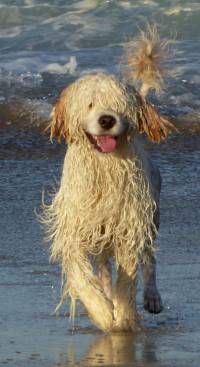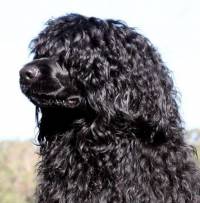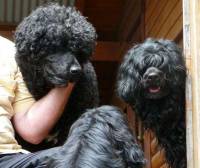Portuguese Water Dog
 Portuguese Water Dog
Portuguese Water Dog
Recently in the spotlight by being former USA President Obama's family dog, the Portuguese Water Dog is an ancient breed. From early times, this Water Dog was regarded as a crew member on the early fishing boats that travelled around the Iberian Peninsula of Spain and Portugal. A dog with a love of the sea, he would stand on the prow (the forward most part) of the boat signalling the presence of shoals of fish. However, he was not recognised as a pure breed until 1938 and by the FCI in 1951[4].
History of the Water Dog
In 1570 AD Caius described both Water Spaniels and Fisher Dogs which had superfluous hair shaven from the shoulders to the hind legs so they would be less hindered when swimming.
 Water Dog c 1665
Water Dog c 1665
Water dogs or 'Canis Aquaticus' were also known along the European coast of France, Portugal and Spain. The wonderful woodcut pictured is by Gervase Markham from in his books 'Hunger Prevention'(1621AD) and 'The Art of Fowling' (1655 AD). He describes the trimming of the describes the trimming of these Water Dogs as follows:
 Portuguese Water Dog
Portuguese Water Dog
"... for the cutting and shaving him from the navel downward or backward is.. because these water dogs naturally are ever most laden with hair on the hinder parts.. which are even deeper in the water than the fore parts, therefore Nature hath given them the greatest armour of hair to defend the wet and coldness; yet this defence in the summer time by violence of the heat of the sun.. is very troublesome.
.. so likewise, in the matter of water, it is a very heavy burden to the dog and makes him to swim less nimbly and slower.... But for the cutting or shaving of a dog all over, even from foot to nostril, that I utterly dislike, for it not only takes from the general benefits which nature hath lent him, but also brings such a tenderness and chillness over all his body, that the water in the end will grow irksome unto him."[1]
The Portuguese Water Dogs' Ancestry
 Barbet (French Water Dog)
Barbet (French Water Dog)
In the background of the the Portuguese Water Dog is the French Water Dog, the Barbet which used to have his hindquarters shaved when swimming as described above. The Barbet has been preserved as a pure breed in France to this day and was finally recognised by the FCI in 2006. The name Barbet came from the name from the French word "barbe" meaning beard, which was the name of the large duck with a beard-like growth of bristles on his bill that the Barbet used to hunt.
 Portuguese Water Dog
Portuguese Water Dog
The Barbet has a coat which is long, woolly and curly and comes in solid black, grey, brown, fawn, pale fawn, white or more or less pied. All shades of red-fawn and pale fawn are also permitted. At between 53 and 65 cm high, he is a similar height to the Portuguese Water Dog.
History of the Portuguese Water Dog
 Portuguese Water Dog
Portuguese Water Dog
This type of Water Dog has been known for centuries along the Iberian Peninsula, as a dog which travelled on fishing boats. He would signal not only shoals of fish, but also the presence of sharks. He also used to swim to shore with the anchor or would instinctively jump into the water to rescue fishermen who fell overboard.
 Portuguese Water Dog
Portuguese Water Dog
The Portuguese Water Dog was not recognised as a pure breed until more than three decades after dog shows commenced in Portugal. The first two Portuguese Water Dogs exhibited were found on fishing boats and were shown at the Lisbon International Show in 1934[2]. The first history of the breed was then written by Professor Fernandes Marques and Vascoe Bensaude. The latter secured a couple more dogs from fishermen and became one of the first breeders of the modern Portuguese Water Dog. The Breed Standard was then written and the breed finally became recognised by the FCI in 1951[4]. But was not until 1996 when Roy Mallinder of the Dassin Kennels first brought them into Queensland, Australia.
Portuguese Water Dog Water Trials
 Portuguese Water Dog rescuing
Portuguese Water Dog rescuing
Today in some parts of the world, modern water trials have been designed as instinct tests to reflect the historical working background of the Portuguese Water Dog. America has created one set of modern water work activities and Portugal, the breed's country of origin has created another. This water work includes retrieving objects from above and below the surface of the water, as well as rescuing people.
 Portuguese Water Dog Retrieving
Portuguese Water Dog Retrieving
The accompanying 3 photos were taken from a beach in the Algarve, Portugal during a week long World Congress held in 2013. This Congress was attended by over 200 Portuguese Water Dog enthusiasts from all over the world. An Australian breeder who attended wrote:
"Many (dogs) had never even seen let alone been in the ocean before as they came from the middle of Europe and England etc. especially for the Congress and had only practised in ponds. So it was a real feat for these dogs to suddenly have salt in their noses and eyes and a current to fight.
Portuguese Water Dog ocean swim
I, and many others beside me, held my breath as each dog worked its way through the exercises to the highest level where they have to retrieve nets and floats from boats and swim them back. The way they also dived down and retrieved weighted floats in those currents was simply awe inspiring!!!. The ocean swim legs where the owners wore flippers to help them swim out and around the buoys and back was a feat of stamina for both dog and human alike... I'm not sure I could even swim the beginner level![3]"
The Portuguese Water Dog Today
 Portuguese Water Dog
Portuguese Water Dog
The Portuguese Water Dog is muscular, strong dog that is slightly rectangular in outline. He stands 50-57 cm (19.5-22.5 ins) for dogs, 43-52 cm (17-20.5 ins) for bitches and weighs 19-25 kg (41 lbs 14 oz - 55 lbs 2 oz) for dogs and 16-22 kg (35 lbs 4 oz - 48 lbs 8 oz) for bitches. He comes in black, white and various shades of brown. He can also be black and white or brown and white although the white must be to a maximum of 30% and confined to the muzzle, neck, chest, front legs, underbelly, rear legs and tip of tail. The skin should look bluish under black, white and black and white dogs.
Coat
 Portuguese Water Dogs
Portuguese Water Dogs
His distinctive profuse coat comes in two distinctly different types, covering whole body except under forelegs and thigh. The line between the two is not clearly defined, but both types are without undercoat. Dogs which work in water usually have waterproof curly, oily or woolly coats. But the Portuguese Water Dog can have a coat which varies between:
- The dog on the left has a short coat with curls
- The other two dogs which have fairly long, loosely waved hair with a slight sheen, especially on the head and ears.
Whether the coat is of the first type and fairly short, or the second type which is longer, the entire hindquarters should be clipped from the last rib. including two-thirds of the tail.
Head and Neck
 Portuguese Water Dog
Portuguese Water Dog
The head has a large skull, which has a central furrow for two thirds its length also has prominent frontal bones and a pronounced occiput. The skull is slightly longer than muzzle with a well defined stop between. The muzzle should taper only slightly, close in a normal scissors bite and the nose should be wide with nostrils well open. The nose should be black in the case of black, black and white or white dogs, but liver in the case of brown, brown and white and dogs with brown tones. The eyes are medium sized and round, but set well apart and should be surrounded by black or dark brown with dark eye rims. The ears are thin in texture, heart shaped, set well above eye level, but the front of the ears are carried close to head. The tips should not extend below the jaw line. The neck, although short should have sufficient length to carry the head proudly. The neck should have no mane or dewlap and be set into well laid shoulders.
Body
 Portuguese Water Dog Beginning with the forelegs, these should be straight, well muscled and strong boned with upright pasterns. The withers are wide but not prominent and the chest wide and deep, reaching to elbow with long, well sprung ribs. The back is short with a good tuck-up and only a slightly inclined croup.
Portuguese Water Dog Beginning with the forelegs, these should be straight, well muscled and strong boned with upright pasterns. The withers are wide but not prominent and the chest wide and deep, reaching to elbow with long, well sprung ribs. The back is short with a good tuck-up and only a slightly inclined croup.
 Portuguese Water Dog
Portuguese Water Dog
Looking from the rear, the hindquarters should be very strongly muscled with long first and second thighs and straight hocks. In profile, although the hind legs should have a definite turn of stifle, the hocks must be strong. The tail is set neither too high nor too low and carried with a ring its end. Because the tail acts as the rudder when the dog is swimming, it should be thick at the base and tapering but should not reach the hock when the dog is standing at rest. The tail is clipped, leaving plume at its end.When moving the Portuguese Water Dog has a proud carriage. When walking he has lively short steps, when trotting has a light and free gait with balanced reach and drive, and is energetic when galloping.
Feet
The feet are extremely important in the Portuguese Water Dog as they have two unique features:
- Designed to assist the dog to swim, the feet are rounded but somewhat flat with a membrane extending over the length of the toes, reaching their tip. As the front feet are generally covered with hair, it is easier to observe this webbing on the back feet where the hair is usually clipped. Note there should be no rear dew claws.
- The Portuguese Water Dog has an usually thick central pad on each foot which holds the nails slightly off the ground. This hard central pad enables the dog to grip the slippery surface of the deck of the fishing boat from which he was required to work[4].
 1. Portuguese Water Dog's large round flat foot
1. Portuguese Water Dog's large round flat foot 2. Portuguese Water Dog's unusually large central pad
2. Portuguese Water Dog's unusually large central pad
References and Further Reading
My sincere thanks to Margo Turnbull for her assistance in providing material and advice in the construction of this page
[1] Hayes Blake Hoyt - 'Your Poodle' - Published by Popular Dogs Publishing Co Ltd, Great Britain 1952. Chapter 1 'Outline of History' Pages 16 - 18
[2] Carla Molinari - The Portuguese Water Dog - Self Published 1993 ISBN: 972-9181-22-5 Chapter 3 Modern History of the Breed Page 35.
[3] Attendee at the 2013 Portuguese World Congress - Margo Turnbull by E-mail 12/10/17
[4] Rui Oliveira - Portuguese Water Dog - The Standards - Type and Morphology